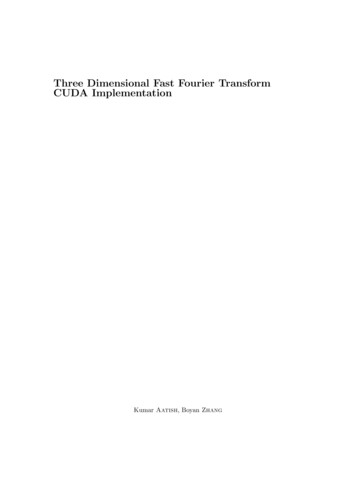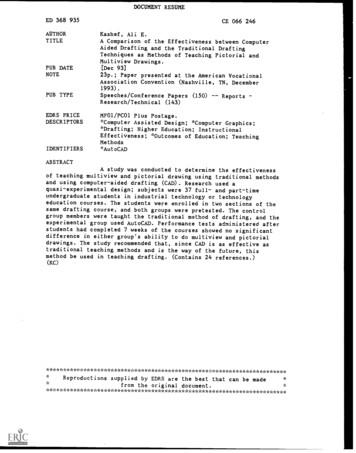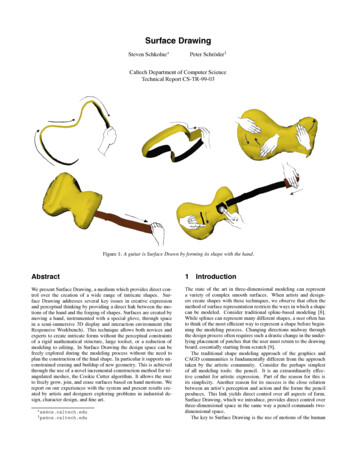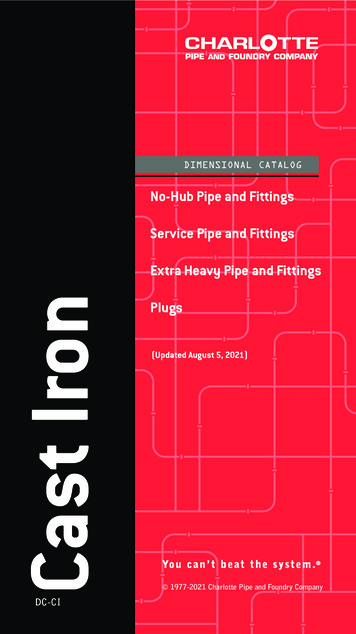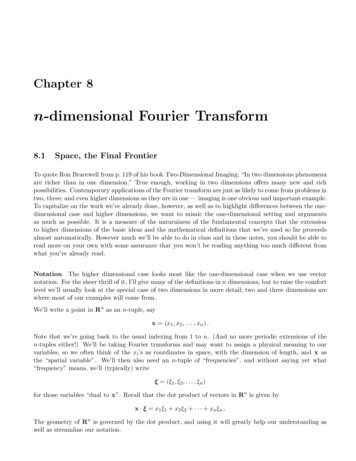
Transcription
Mechanical properties of two-dimensional materials andheterostructuresKai Liua)School of Materials Science and Engineering, Tsinghua University, Beijing 100084, ChinaJunqiao Wub)Department of Materials Science and Engineering, University of California, Berkeley, California 94720, USA; andMaterials Sciences Division, Lawrence Berkeley National Laboratory, Berkeley, California 94720, USA(Received 24 August 2015; accepted 5 October 2015)Mechanical properties are of fundamental importance in materials science and engineering,and have been playing a great role in various materials applications in the human history.Measurements of mechanical properties of 2-dimensional (2D) materials, however, areparticularly challenging. Although various types of 2D materials have been intensivelyexplored in recent years, the investigation of their mechanical properties lags much behindthat of other properties, leading to lots of open questions and challenges in this research field.In this review, we first introduce the nanoindentation technique with atomic force microscopyto measure the elastic properties of graphene and 2D transition metal dichalcogenides. Thenwe review the effect of defects on mechanical properties of 2D materials, including studies onnaturally defective chemical-vapor-deposited and intentionally defective 2D materials. Lastly,we introduce a nano-electromechanical device, resonators, built on the basis of the excellentmechanical properties of 2D materials.I. INTRODUCTIONMechanical properties are probably the first aspect thatpeople pay attention to in exploring a new material.Stone, bronze, and iron are the three milestone materialsthat appeared synchronically in ancient times. Thesematerials were discovered, selected, and refined, mostlydue to their outstanding mechanical properties, as well ascost-effective ways of production. Stone is rigid, butbrittle and difficult to processing, while bronze and ironare stronger, tougher, and easier for shaping. Theirutilizations have greatly changed the human history andthey are used to name the ancient periods (i.e., StoneAge, Bronze Age, and Iron Age). As increasingly fastdiscoveries of new functional materials are made inmodern times, mechanical properties are no longer theonly properties that are concerned. However, they are stillthe key criteria in seeking super-strong or super-rigidmaterials for applications ranging from people’s daily lifeto space exploration.1,2,3,4 In semiconductors, they areindispensable complements to electrical and opticalproperties of materials.5,6 Mechanical properties haveContributing Editor: Jeremy T. RobinsonAddress all correspondence to these authors.a)e-mail: liuk@tsinghua.edu.cnb)e-mail: wuj@berkeley.eduDOI: 10.1557/jmr.2015.324also played vital roles in designs of flexible, stretchable,and epidermal electronics which may potentially dominate the future electronics industry.7,8,9Nano-science and nano-technology have attracted intensive attention for the past 30 years.10,11,12,13,14,15,16,17In two-dimensional (2D) materials, electrons andphonons are limited in a planar dimension, andtherefore many of their properties deviate from their3D counterparts.16 Two representative examples aregraphene and most transition metal dichalcogenides(TMDs) such as molybdenum disulfide (MoS2), which,in the monolayer limit features massless Dirac fermions18and an intrinsic direct band gap, respectively,19,20 leadingto a variety of intriguing electrical and opticalproperties. 21,22,23,24,25,26,27,28 On the other hand, animportant question arises: whether the mechanical properties of 2D materials become also different in themonolayer limit. In 3D, elastic modulus E and Poisson’sratio m are used to determine elastic properties ofmaterials. E is also called Young’s modulus when theapplied strain is uniaxial, following E ¼ r e, where r isstress and e is strain. Poisson’s ratio m is defined as thenegative ratio of transverse to axial strain under uniaxialstress. Another important parameter is tensile strength,which describes the maximum tension that a material canwithstand. Elastic modulus and tensile strength are scaledby the change of volumetric elastic energy, thus havinga units of J/m3 or Pa. In 2D, however, these parametersDownloadedAccesspaidby No.the UC2017 at 15:39:07,subjectto the CambridgeCore terms of use, available at832 from https://www.cambridge.org/core.J. Mater. Res.,Vol.31,7,BerkeleyApr 14,Library,2016 on bridge.org/core/terms. https://doi.org/10.1557/jmr.2015.324
K. Liu et al.: Mechanical properties of two-dimensional materials and heterostructureshave to be renormalized by the planar elastic energy,leading to a units of J/m2 or N/m. Although 2D modulusand strength are more suitable to describe 2D materials,for the purpose of comparison between 2D and 3Dmaterials, these 2D parameters can be converted to 3Dones by dividing the 2D values with the thickness of the2D materials. With these concepts, the conventionalelastic theory can be readily applied to 2D systems.However, there are many new aspects of mechanicalproperties in 2D systems that are different from 3Dsystems, as we will discuss later in this review. The firststep to probe mechanical properties of 2D systems ismore technical; that is, how to accurately measure themechanical properties of 2D materials.II. GRAPHENE—THE STRONGEST MATERIALIf the system is 1D, such as a carbon nanotube or anultra-thin silicon nanowire, measurements of Young’smodulus seem to be straightforward. Stretching a nanotubeor nanowire is an effective way to directly determine itsmechanical properties.1,29,30,31 However, the measurementsof 2D systems appear to be more difficult, becauseuniformly stretching a 2D membrane is challenging. Abreakthrough occurred in 2008, when Lee et al. inColumbia University utilized an atomic force microscope(AFM) nanoindentation to probe suspended, circular graphene membranes.3 The AFM tip is pushing the center ofthe membrane (Fig. 1). When the tip radius is tiny (rtip rhole), the load applied by the AFM tip can be considered asa point load. In a simplified continuum mechanics model,the applied load is related to the deformation geometry ofthe membrane,3,32,33 3 2D 2D qd3 ;F ¼ r0 p d þ Eð1Þr2where F is the applied point load force, d is theindentation depth at the center of the membrane, r isthe hole radius, q 5 1/(1.05 0.15m 0.16m2) isa dimensionless constant determined by the Poisson’sratio, m, of the membrane, E 2D and r2Dare the 2D0modulus and the 2D pretension, respectively (Fig. 1).FIG. 1. Illustration of probing mechanical properties of 2D materialsby AFM nanoindentation.Equation (1) ignores contributions from the bendingmodulus because it is negligible in such an ultrathinmonolayer membrane. Initially, the applied loadscales linearly with the indentation depth when it is small(F ; d), and the coefficient is dominated by thepretention; when the indentation depth is large, the loadis dominated by the stiffness of the membrane witha cubic relationship (F ; d3). Graphene and TMDs havea lattice with 6-fold- or 3-fold-symmetry, leading tonearly isotropic mechanical properties in the plane. Thusthe above model can be applied to the measurements ofmechanical properties of these 2D materials.In Eq. (1), the Poisson’s ratio is an important parameterbecause it determines q while E 2D scales reversely withthe third power of q. The Poisson’s ratio of graphene hadbeen actually controversial for a few years. Bulk graphitewas reported to have a Poisson’s ratio of 0.16 in the basalplane.34 Ab initio calculation reveals an isotropic in-planeelastic response of graphene at small strains with a Poisson’s ratio of 0.186, which, at large strains, becomesanisotropic and strongly dependent on the strain values.34On the other hand, molecular dynamic simulations showa Poisson’s ratio of 0.21 for bulk graphene, and the ratiosignificantly depends on the size and chirality in the caseof graphene nanoribbons, with a larger value in thearmchair direction than in the zigzag direction.35 Despitethe wide distribution of Poisson’s ratio ranging from 0.16to 0.21, it merely introduces an error of ;1% in thecalculated constant q, or ;3% for q3, which is a negligible error for mechanical measurements.Experimentally, monolayer graphene is mechanicallyexfoliated onto substrates drilled with holes with variousdiameters, such that the graphene membranes with desired diameters are suspended over the holes [Figs. 2(a)and 2(b)]. The indentation depth is determined by thedisplacement of the scanning piezo-tube of AFM (Dzp)and the deflection of the AFM tip (Dzt), and the appliedload is obtained by multiplying the deflection of the AFMtip with its spring constant (Fig. 1). E 2D and r2D0 can bederived by a least-square fitting of the experimental forcedisplacement [F(d)] curves with Eq. (1) [Fig. 2(c)]. Byaveraging over numerous times of measurements, Leeet al. obtained a mean value of E2D equal to 342 N/m,with a standard deviation of 30 N/m [Fig. 2(d)]. Theuncertainty of their elastic modulus measurement is notlarge, only ;14%. The derived values of r2D0 rangesfrom 0.07 to 0.74 N/m, which are higher even than thefracture strength of many conventional materials.3 Thepositive pretentions may result from adhesion of graphene membrane to the vertical wall of the hole, tautlystretching the graphene membrane [Fig. 2(b)]. Assumingan effective graphene thickness of 0.335 nm, the derivedE2D corresponds to an ultrahigh 3D Young’s modulus of1.0 6 0.1 TPa, very close to the theoretical value36,37 andthe in-plane Young’s modulus of bulk graphite.34Downloaded from https://www.cambridge.org/core. Access paid by the UCon 1131,Oct No.2017 7,at 15:39:07,J.BerkeleyMater.Library,Res., Vol.Apr 14, subject2016 to the Cambridge Core terms of use, available athttps://www.cambridge.org/core/terms. https://doi.org/10.1557/jmr.2015.324833
K. Liu et al.: Mechanical properties of two-dimensional materials and heterostructuresFIG. 2. Mechanical properties of exfoliated graphene: (a) scanning electron microscope image of a monolayer graphene exfoliated on a holeysubstrate, from Ref. 3; (b) detailed AFM image with a height profile across the dashed line, from Ref. 3; the diameter of the central hole is 1 lm;(c) typical experimental and fitted force–displacement curves, which reach the cubic behavior at high loads (inset), from Ref. 3; (d) statisticalhistogram and Gaussian distribution of measured E2D, from Ref. 3.This nanoindentation process can also be used to probethe tensile strength of graphene by indenting it to itsbreaking point. Based on a continuum model, the maximum stress for a tightly clamped, linear elastic, andcircular membrane under a spherical indenter is given by38 r2Dm¼FE2D4prtip 1 2;ð2Þwhere F is the breaking force, and rtip is the tip radius.Equation (2) shows that the breaking force scales with thetip radius. For graphene, the measured data yields a mean2D tensile strength of 55 N/m, corresponding to a 3Dtensile strength of 130 6 10 GPa.III. EFFECTS OF DEFECTSBoth the measured elastic modulus and tensile strengthof graphene have the highest values among all naturalmaterials. It arises from the extremely strong sp2 C–Cbonding in graphene, as well as its free from notablemicroscopic defects when exfoliated from high-qualitybulk graphite. However, defects exist ubiquitously inall materials. In graphene, carbon atoms could be lostor displaced, generating point defects including monovacancies, di-vacancies, and Stone–Wales defects (5–7defects). Line defects such as grain boundaries are alsoobserved in graphene by atomically resolved transmission electron microscopy (TEM).39 The existence ofthese defects raises a question of how the mechanicalproperties of graphene are affected by defects. Theoretical simulations show that point defects weaken theelastic modulus and tensile strength of graphene,40,41but grain boundary defects can enhance or weaken thestrength of graphene depending on the tilt angles,42,43suggesting that not only defect density affects mechanicalproperties of graphene, but also the arrangements andinteractions between defects are important. In addition,a movement of edge dislocation pairs along the zig-zaglattice direction was observed under a low-voltage, highresolution TEM by Warner et al.44 These edge dislocations result in a substantial bond compression or elongation of 627%, and their movement may contribute to theplasticity of graphene, as dislocation movement is the keymechanism for materials plastic deformation.44In large-area graphene synthesized by chemical vapordeposition (CVD),45,46 point defects and grain boundariesare very common [Figs. 3(a) and 3(c)].39,48,49,50 CVDgraphene thus provides a good platform to test the effectof defects and grain boundaries. Early experiments showthat CVD graphene has much lower Young’s modulusand tensile strength than exfoliated graphene.51,52 RuizVargas et al. reported an average modulus of 55 N/m anda breaking strength of ;35 GPa, only 1/6 and 1/4 of theDownloadedBerkeleyLibrary,11No.Oct 2017at 15:39:07,subject to the Cambridge Core terms of use, available at834 from https://www.cambridge.org/core. Access paid by theJ. UCMater.Res.,Vol.on31,7, Apr14, 2016https://www.cambridge.org/core/terms. https://doi.org/10.1557/jmr.2015.324
K. Liu et al.: Mechanical properties of two-dimensional materials and heterostructuresFIG. 3. Mechanical properties of CVD graphene: (a and b) a small-grain graphene: dark-field transition electron microscope (DF-TEM) imagewith false color (a) and histogram of its E2D (b), from Ref. 47; (c and d) DF-TEM images and E2D of a large-grain graphene, from Ref. 47;(e) bright-field TEM image of a small-grain graphene over a hole, from Ref. 47; (f) AFM indentation on different grain boundaries and on the centerof the membrane as shown in (e), from Ref. 47.values of exfoliated, single-crystal graphene, respectively.51 However, detailed studies reveal that theobserved reduction in modulus and strength may originate from ripples or additional defects resulted from thetransfer process.47,51 If polymethyl methacrylate(PMMA) is coated on graphene to assist the transfer,liquid acetone is usually needed to remove the PMMA atthe last step, which introduces an additional surfacetension on the suspended monolayer membrane, ripplingthe membrane and weakening its modulus and strength.Instead of PMMA, Lee et al. adopted polydimethylsiloxane (PDMS) as the transfer medium. They first transferred the graphene onto PDMS, and then stamped thegraphene onto the target holey substrates.47 This drytransfer avoids surface tension and yields taut, suspendedCVD graphene membrane, which is desired for measurements of intrinsic mechanical properties. With this effort,Lee et al. obtained an E2D of 328 6 17 and 339 6 17N/m for small-grain and large-grain CVD graphene[Figs. 3(a)–3(d)], both very close to the value ofexfoliated, single-crystal graphene (;340 N/m). AFMindentations on grain boundaries show that facture occursat a slightly lower load than the indentation at the centerof a membrane [Figs. 3(e) and 3(f)]. The averagebreaking strength of graphene with small and wellstitched grain, 33 N/m (98.5 GPa), is slightly smallerthan that of exfoliated graphene (130 GPa).3,47 Theseexperimental and simulating results are quite surprisingbecause a common wisdom is that a reduction of bothmodulus and strength is expected by defects and grainboundaries. It indicates that defects or grain boundariesplay very special roles beyond normal expectation in themechanical properties of graphene, or even other 2Dmaterials.As CVD graphene is almost as strong as exfoliatedones, the role of defects in graphene seems to becontradictory to the common sense that defects oftenweaken the strength of materials. One possibility is thatthe defect density in CVD graphene, although considerable from an electronic point of view, is still too low toaffect the mechanical strength. Therefore, quantificationof the dependence of mechanical properties of grapheneon defect density becomes necessary. For this purpose,defects need to be intentionally introduced into graphene.Zandiatashbar et al. generated defects in graphene bya gentle oxygen plasma etching.53 Defect types anddensities are estimated from the ratio of the newlyappearing D peak to the G peak in the Raman spectra[Figs. 4(a) and 4(b)].55,56 When the etching time is short,sp3-type defects form, while with increasing etching time,vacancy defects appear. The 2D modulus of graphenewas found to be insensitive to defects in the sp3-typedefect regime, while in the vacancy-defect regime, itdrops significantly [Fig. 4(a)]. In contrast, the breakingstrength (scaling with square root of breaking load) ofgraphene decreases monotonically with increasing defectdensities induced by the oxygen plasma, although itdrops only by ;14% over the entire sp3-type defectDownloaded from https://www.cambridge.org/core. Access paid by the UCon 1131,Oct No.2017 7,at 15:39:07,J.BerkeleyMater.Library,Res., Vol.Apr 14, subject2016 to the Cambridge Core terms of use, available athttps://www.cambridge.org/core/terms. https://doi.org/10.1557/jmr.2015.324835
K. Liu et al.: Mechanical properties of two-dimensional materials and heterostructuresFIG. 4. Effects of defects on mechanical properties of graphene: (a and b) E2D and breaking strength of defective graphene induced by oxygen plasmaetching, from Ref. 53; (c) E2D as a function of the density of defects introduced by Ar1 irradiation, showing a non-monotonic behavior, from Ref. 54;(d) schematic pictures of thermal fluctuation of a suspended graphene membrane, and (e) of a defective graphene, from Ref. 54.region [Fig. 4(b)]. This discovery implies that in thisregime graphene may be covalently bonded with itself orto the substrate, counteracting the weakening of mechanical properties.53Although oxygen plasma etching is an effective way tocreate defects, it is not a well-controlled method, becauseit is based on chemically reactive etching that has a fastetching rate, and tends to expand existing defects ratherthan generate new ones. Instead, López-Polín et al.controlled defects in monolayer graphene by a lowenergy irradiation with argon ions (140 eV Ar1).54 Thisphysical process creates defects uniformly and avoids theselective etching induced by oxygen plasma. With thismore controlled technique, they reported an abnormalincrease of E2D by almost a factor of 2 at a vacancycontent of 0.2% [Fig. 4(c)]. Further increasing the defectdensity reduces E2D. The initial increase of E2D wasattributed to dependence of E2D on the momentum offlexural modes predicted for 2D membranes. In graphene,the low bending rigidity introduces significant thermalfluctuations and strong anharmonic effects, which introduces a wavevector-dependent elastic modulus. Longwavelength excitations are favorable in large and cleansamples [Fig. 4(d)], but they are suppressed in defectivesamples [Fig. 4(e)], leading to an effective increase of themeasured E2D. This abnormal increase of E2D cannot bethoroughly understood from the conventional continuummechanics, and quantum and atomic-scale theoriesshould be also considered in accurately describing themechanics of 2D membranes.54In multilayer graphene, an interesting topic is the effectof defects on the interaction between graphene layers. Theinterlayer interaction is crucial for many applications. Forexample, a weak interaction is desired for applicationsin high-performance electrochemical devices includingbatteries and supercapacitors that involve atomic intercalation into the space between layers.57 In defectivegraphene multilayers, however, whether the interlayerinteraction of graphene is enhanced or weakened hasbeen an open question. Liu et al. used high-energyirradiation with a particles to introduce defects in graphene with different number of layers, and explored theirelastic modulus as a function of the irradiation dose by theAFM nanoindentation method.58 They found that inirradiated multilayer graphene, carbon atoms tend to forminterlayer linking around the defects and partially restorethe degraded modulus. As a result of such interlayerlinking, the elastic modulus of multilayer graphene showshigher resistance to radiation damage as compared tomonolayers. This finding reveals the importance ofinterlayer linking in graphene from the mechanicalperspective, and the interlayer linking may also exist inother 2D materials and heterostructures. It also sheds lightfor possibly engineering mechanical properties of 2Dmaterials with controlled defects.IV. MECHANICAL PROPERTIES OF 2D TMDSAlthough graphene has been proven to be the strongestmaterial ever measured, its native zero band gap haslimited its applications in semiconducting industry.59,60As a result, TMDs, such as MoS2, WS2, and WSe2,have attracted much attention in recent years due tothe existence of a band gap, and their crossover fromindirect band gap in bulk to direct band gap in themonolayer limit.17 This opens up a wide range ofDownloadedBerkeleyLibrary,11No.Oct 2017at 15:39:07,subject to the Cambridge Core terms of use, available at836 from https://www.cambridge.org/core. Access paid by theJ. UCMater.Res.,Vol.on31,7, Apr14, 2016https://www.cambridge.org/core/terms. https://doi.org/10.1557/jmr.2015.324
K. Liu et al.: Mechanical properties of two-dimensional materials and heterostructuresapplications for monolayer TMDs in electronics andoptoelectronics.24,61,62 2D TMDs have also been usedas key components in flexible electronics,63,64,65,66 inwhich their mechanical properties become relevant andimportant. The first reports on mechanical properties ofTMD layers aim at less-defective, exfoliated flakes ofMoS2. Bertolazzi et al. utilized a similar AFM nanoindentation to measure the mechanical properties ofexfoliated mono- and bi-layer MoS2.67 The in-plane 2Dmodulus of monolayer MoS2 was determined to be180 6 60 N/m (270 6 100 GPa), and the averagebreaking strength 15 6 3 N/m (23 GPa), which areseveral times lower than monolayer graphene but stillmuch stronger than steel. The pretention lies between0.02 and 0.1 N/m. In contrast, bilayer MoS2 has a 2Dmodulus of 260 6 70 N/m, corresponding to a lower 3Dmodulus of 200 6 60 GPa, which is attributed to defectsor interlayer sliding.67 On the other hand, CastellanosGomez et al. studied the elastic properties of suspended,thick MoS2 sheets with 5–25 layers.68 In their work, thebendingh rigidity ihas to be considered and one more linearterm,4pE2D3ð1 t2 Þ2 rt 2 d, needs to be added into Eq. (1), wheret and r are the thickness and the radius of membrane,respectively. Despite this additional term, the modulusand the pretension can be similarly derived by fitting tothe experimental force–displacement curves. Theyobtained a mean Young’s modulus of 330 6 70 GPa,and a pretention of 0.13 6 0.10 N/m.68 Both values arehigher than the results obtained by Bertolazzi et al.,67 andboth modulus values obtained by these two groups arehigher than bulk MoS2 (;240 GPa).69A similar question to that in graphene appears here in2D TMDs, that is, whether CVD samples have similarmechanical properties as exfoliated samples. CVD isa widely applied method to grow large-area materials incost-effective ways. But CVD samples are usually moredefective compared to single crystals. So far, peoplehave developed CVD methods to synthesize largearea,70,71,72,73 or even wafer-scale,74 2D TMDs such asMoS2. The as-grown samples consist of isolated trianglesof monolayer crystals at positions on the substrateslightly far away from the precursors, and mergedcontinuous film closer to the precursors [Figs. 5(a)–5(c)].Liu et al. transferred CVD MoS2 and WS2 with a similarPDMS stamping process onto holey substrates [Figs. 5(d)and 5(f)],75 as Lee et al. did in CVD graphene,47 toavoid ripples that complicated the measurements ofmechanical properties. They also employ the AFMnanoindentation to probe the modulus of monolayerCVD MoS2 and WS2, finding values of 171 6 11(264 GPa) and 177 6 12 N/m (272 GPa), respectively[Figs. 5(f) and 5(g)]. The nearly identical valuesbetween MoS2 and WS2 originate from their similarlattice constants and bonding energies. First-principlescalculations predict a 2D modulus of 123 N/m forFIG. 5. Measurements of CVD MoS2 and WS2 monolayers: (a–c) as-grown CVD MoS2 samples (a), consisting of isolated-triangle part (b) andcontinuous film (c), from Ref. 75; (d) AFM image of an entire triangle transferred onto a holey substrate, from Ref. 75; (e) AFM image ofa suspended membrane over a hole, from Ref. 75; (f and g) histograms of E2D for MoS2 and WS2, and the corresponding Guassian distribution,from Ref. 75.Downloaded from https://www.cambridge.org/core. Access paid by the UCon 1131,Oct No.2017 7,at 15:39:07,J.BerkeleyMater.Library,Res., Vol.Apr 14, subject2016 to the Cambridge Core terms of use, available athttps://www.cambridge.org/core/terms. https://doi.org/10.1557/jmr.2015.324837
K. Liu et al.: Mechanical properties of two-dimensional materials and heterostructuresMoS2 and 137 N/m for WS2, both lower than experimental values, which is consistent with the fact thatthe used DFT-GGA calculation usually underestimatesthe bulk modulus of semiconductor materials.76 Notethat Liu et al. only measure the membranes witha single grain, so the effect of grain boundaries is notprobed here. All of the elastic moduli and breakstrengths for 2D materials ever measured are listed inTable I. The modulus of CVD MoS2 (;170 N/m) isonly ;5% lower than that of exfoliated MoS2(;180 N/m),67 similar to the case in CVD grapheneversus exfoliated graphene. It may imply that pointdefects in CVD samples do not significantly affect themechanical properties of CVD samples. However,there is no simple way to quantify the defects in 2DTMDs, because unlike graphene, 2D TMDs have nodefect-related Raman peaks. This leaves an interestingtopic for quantifying the relationship between mechanical properties and defects density in 2D TMDs.TABLE I. Elastic properties of 2D materials ever measured.MaterialsGraphiteExfoliated graphene (1L)CVD graphene (1L)Bulk MoS2Exfoliated MoS2 (1L)Exfoliated MoS2 (ML)CVD MoS2 (1L)CVD WS2 (1L)3D Young’smodulus (GPa)10001000979240270330264272Tensilestrength (GPa) References.13098.5.23.343476967687575Note: “1L” and “ML” indicate monolayer and multilayer, respectively.V. 2D VAN DER WAALS HETEROSTRUCTURESStacking a 2D sheet onto another by van der Waalsinteractions and forming a heterostructure may be themost promising advantage of 2D materials in electronicapplications (Fig. 6).60 This provides a simple, controllable way to build up heterostructures with desired bandalignments.77 Their great potentials in optoelectronicsand multi-junction solar cells have aroused lots of studiesin recent years.78,79,80,81 Interlayer coupling has beenfound to play a great role in the performance of 2Dheterostructure-based devices, and has been investigatedintensively from the electrical or optical perspective.82,83,84,85,86 However, mechanical probing of theheterostructures is still lacking.There are some ways to investigate the interlayercoupling from a mechanical point of view. It seems tobe not so difficult in 2D homostructures, such asmultilayer graphene or bulk graphite. Tan et al. measuredthe interlayer shear Raman modes in low energies inmultilayer graphene.87 The corresponding Raman peaksshift from bilayer graphene (;31 cm 1) to bulk graphite(;43 cm 1), suggesting that the peaks are related tointerlayer interaction. With a deeper analysis, the shearmodulus across the layer–layer interface is derived to be4.3 GPa in graphite.88 This indirect method could be alsoapplied to 2D heterostructures. Koren et al. used an AFMto apply lateral shear force on predesigned highlyoriented pyrolytic graphite (HOPG) patterns.89 Thisinduces a shear gliding along a random single basalplane in the HOPG patterns, from which the lateral shearforce and the friction force can be obtained. The interfaceadhesion energy is measured to be 0.227 6 0.005 J/m2,which is agreement with theoretical models. It is a directFIG. 6. Schematic of van der Waals heterostructures, from Ref. 60.DownloadedBerkeleyLibrary,11No.Oct 2017at 15:39:07,subject to the Cambridge Core terms of use, available at838 from https://www.cambridge.org/core. Access paid by theJ. UCMater.Res.,Vol.on31,7, Apr14, 2016https://www.cambridge.org/core/terms. https://doi.org/10.1557/jmr.2015.324
K. Liu et al.: Mechanical properties of two-dimensional materials and heterostructuresmethod to quantify the interlayer interaction in 2Dhomostructures, but it is not very suitable to probeheterostructures, because thick 2D materials are requiredin their method but it is difficult to form thick heterostructures by stacking monolayers, and the basal planewhere the shear gliding occurs is difficult to be wellcontrolled at the hetero-interface.Mechanically probing the interlayer interaction in 2Dheterostructures is still a challenge. With a purpose ofattempting to address this, Liu et al. probed the elasticmodulus of 2D bilayer heterostructures by the wellestablished nanoindentation process, along with theirmeasurements of 2D TMD monolayers.75 They foundthat the measured E2D of bilayer heterostructures arealways lower than the sum of E2D of each layer, implyingan interlayer sliding that depends on the interlayerinteraction [Fig. 7(a)]. In their experiments, the bilayeris suspended over a circular hole. The bottom layer indirect contact with the substrate is firmly clamped ontothe substrate. In the extreme case of a very stronginterlayer interaction, there is no interlayer slidingallowed, such that both layers contribute to the 2Dmodulus measured. In the opposite extreme, however,when the top layer is completely free to slide against thebottom layer, the measured modulus of the bilayer issolely given by the bottom layer that
materials for applications ranging from people’s daily life to space exploration.1,2,3,4 In semiconductors, they are indispensable complements to electrical and optical properties of materials.5,6 Mechanical properties have also played vital roles in designs of flexible, stretchab

